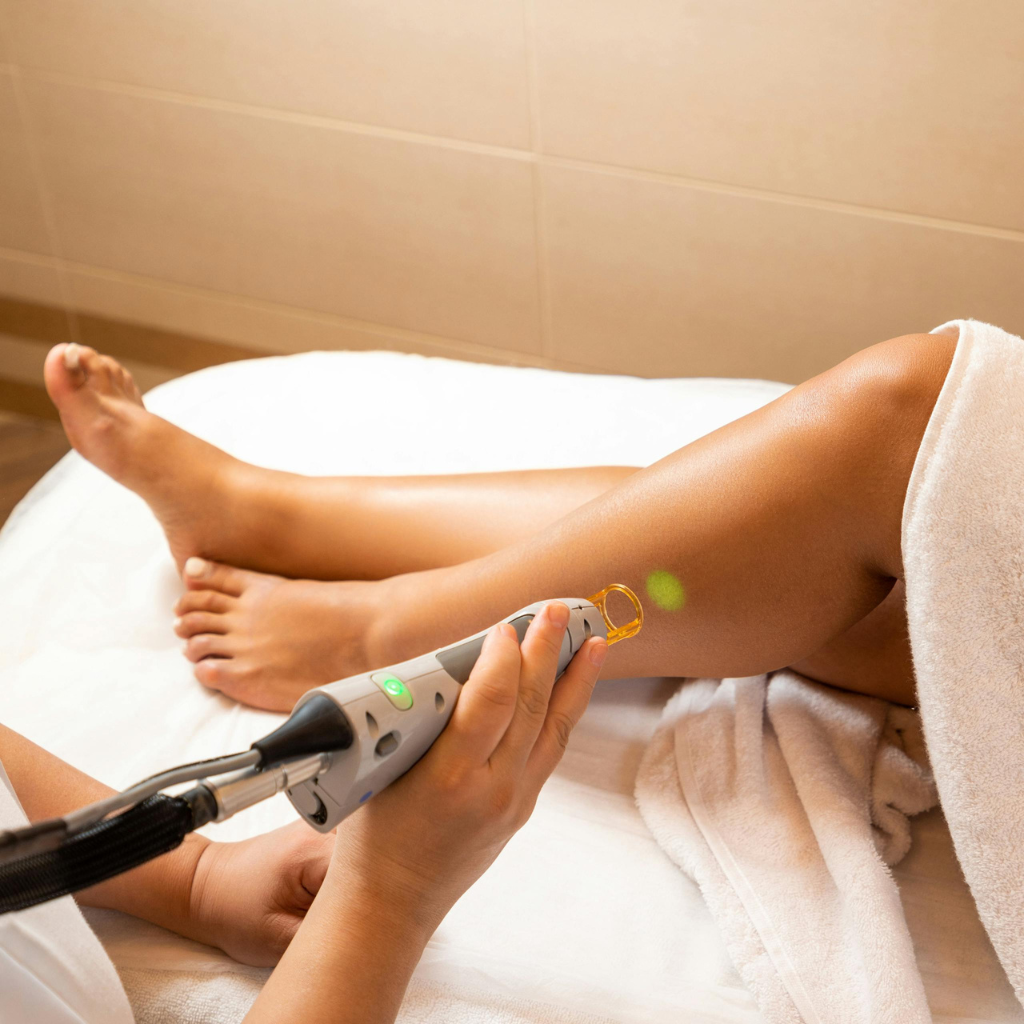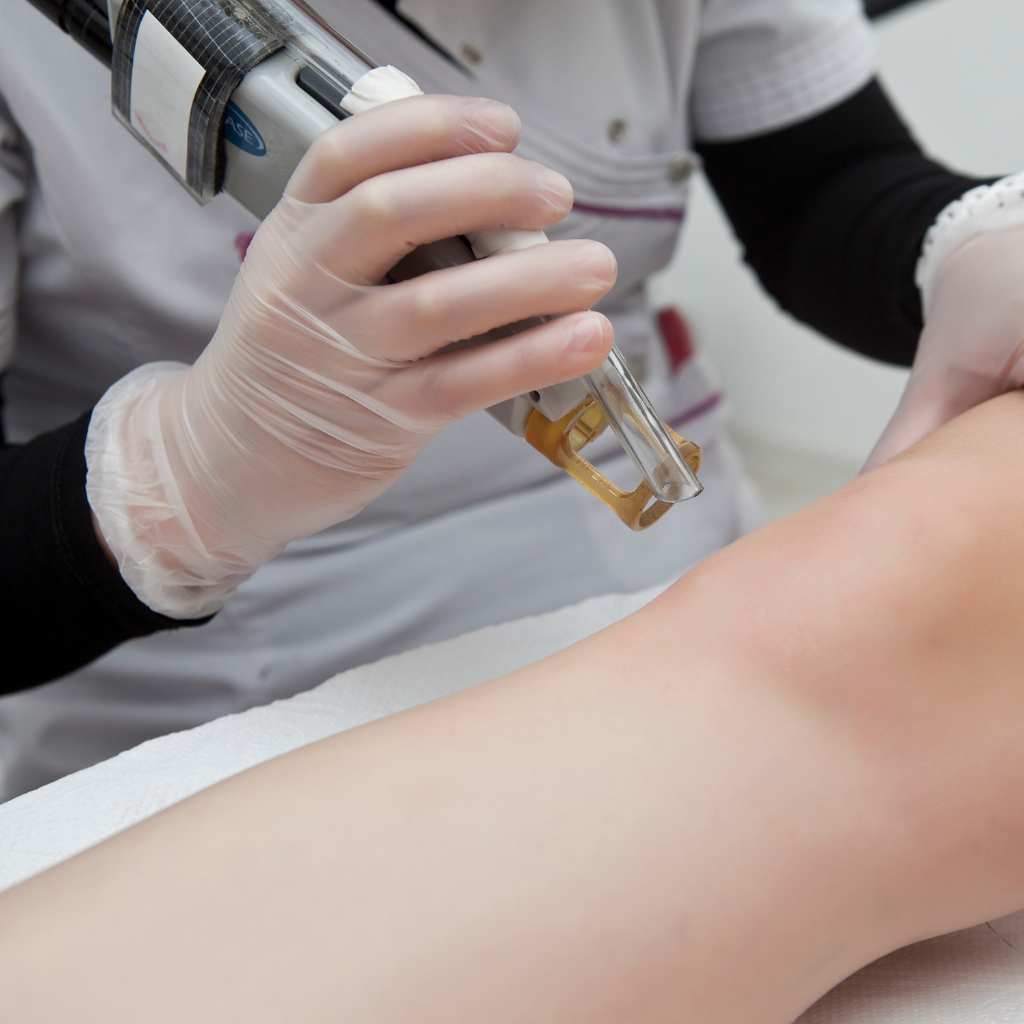How Long Does Laser Hair Removal on Legs Last With Proper Care?
- Home
- Laser Hair removal
- how long does laser hair removal last on legs

Laser hair removal on legs can offer lasting results from several months to years with proper aftercare. The treatment disrupts hair follicle cycles, reducing regrowth. An average of 6-8 sessions guarantees maximum efficacy, initially spaced 4-6 weeks apart. Proper care, including sun protection and moisturisation, enhances effectiveness. Suitability varies based on skin and hair types, with dark hair on light skin yielding the best outcomes. For more insights, further information is available.
Key Takeaways
- Results can last several months to years with consistent and proper aftercare routines.
- An average of 6-8 sessions is recommended for optimal and long-lasting results.
- Maintenance sessions are typically needed every 6-12 months after initial treatments.
- Avoiding sun exposure and using broad-spectrum sunscreen prevents hyperpigmentation.
- Dark hair on light skin generally leads to more efficient and durable outcomes.
How Long Does Laser Hair Removal Last on Legs with Aftercare?
The longevity of laser hair removal on legs, when coupled with appropriate post-treatment care, typically spans several months to years due to the disruption of hair follicle cycles.
Proper aftercare, which includes moisturising, avoiding sun exposure, and refraining from irritants, plays an essential role in prolonging results and minimising adverse effects.
Significantly, the efficacy and duration of hair removal treatments can vary between legs and other body areas due to differences in hair density and growth patterns.
How Long Does Laser Hair Treatment Last with Proper Post-Care?
How long can one expect the results of laser hair treatment on the legs to last with diligent aftercare?
The longevity of laser hair removal primarily depends on the individual’s hair growth cycle and adherence to recommended laser hair removal aftercare. Typically, laser treatment for leg hair removal targets hair follicles in the anagen phase, effectively reducing hair regrowth.
With proper aftercare, including sun protection and avoidance of irritants, the laser hair removal procedure’s efficacy is maximised.
Scientific evidence suggests that the results of laser hair removal can last several months to years, with periodic maintenance sessions enhancing outcomes.
As the laser hair removal treatment disrupts the hair growth cycle, the need for frequent shaving diminishes, optimising the laser hair removal legs’ results.
How Can You Care for Skin After a Leg Laser Hair Removal Session?
Maximising the longevity of laser hair removal on the legs involves meticulous post-treatment skin care. Proper aftercare guarantees ideal results and prolongs long-term hair reduction by addressing the effects of laser hair removal.
- Avoid Sun Exposure: The treated area should be shielded from UV rays to prevent hyperpigmentation and accelerated hair growth. Sunscreen with high SPF is recommended.
- Moisturise Regularly: Hydrating the skin and hair follicles in the affected region aids in reducing irritation and supports the healing process.
- Refrain from Other Hair Removal Methods: Techniques like waxing or plucking disrupt the hair removal session’s efficacy.
- Monitor for Irritation: Observing the skin for adverse reactions guarantees timely intervention, maintaining the integrity of the hair removal treatment.
These steps assure ideal care and effective management of unwanted hair.
How Do Hair Removal Treatments Differ for Legs vs. Other Areas?
While laser hair removal effectively reduces unwanted hair across various body regions, anatomical differences necessitate tailored approaches for each area. Legs typically require more sessions due to the larger surface area and varied hair types. The efficacy of laser hair removal on legs depends on hair colour and density, with darker hair responding more favorably. In contrast, smaller areas like the face or underarms may see quicker results due to higher follicle concentration. Each laser hair removal session is meticulously calculated based on these variables to guarantee ideal long-term hair removal.
| Body Area | Hair Type Considerations | Session Frequency |
|---|---|---|
| Legs | Varied hair color | 6-8 weeks apart |
| Face | Finer, lighter hair | 4-6 weeks apart |
| Underarms | Coarser hair | 4-6 weeks apart |
Tailored hair removal treatments guarantee efficacy across different body hair regions.
How Many Laser Hair Removal Treatments Do You Need for Smooth Legs?
Several factors, including the frequency of treatments, the efficacy of each session, and individual hair growth cycles, influence the number of laser hair removal sessions required to achieve smooth legs.
Clinically, it is often recommended to schedule sessions every 4-6 weeks, with an average of 6-8 sessions needed for ideal results.
Variations in hair density and growth phase synchronisation can affect the total session count necessary for substantial hair reduction.
How Often Should You Get a Laser Hair Removal Session on Your Legs?
How frequently should one undergo laser hair removal sessions to achieve smooth legs? The ideal interval for sessions for laser hair removal on legs is essential for effective hair removal treatment. Evidence suggests following these guidelines:
- Initial Sessions: Typically every 4 to 6 weeks. This schedule targets hair regrowth during the anagen phase, maximising laser hair removal results.
- Maintenance: Post initial treatments, sessions may be spaced 6 to 12 months apart to maintain permanent hair removal outcomes.
- Individual Variability: Factors like skin type, hair colour, and density impact how often laser hair removal on the legs is needed. Consultation with a hair removal specialist is recommended.
- Cost Considerations: The cost of laser hair removal varies. Efficient scheduling reduces overall expense while managing unwanted hair growth effectively.

How Many Sessions of Laser Hair Removal Treatment Are Effective?
Determining the number of laser hair removal sessions necessary for achieving smooth legs involves understanding the hair growth cycle and laser technology. Laser hair removal treatments for legs typically require 6 to 8 sessions for ideal results. This is due to the need to target hair follicles during their active growth phase. Sessions for laser hair removal on legs are spaced weeks apart, allowing for effective reduction in hair growth. The laser treatment’s success is influenced by factors such as hair thickness, skin type, and the laser’s wavelength. As laser hair removal may not eliminate all unwanted body hair, maintenance sessions contribute to long-term hair reduction.
| Sessions Required | Hair Thickness | Expected Outcome |
|---|---|---|
| 6-8 | Thick | Significant reduction |
| 8-10 | Medium | Moderate reduction |
| 10+ | Fine | Minimal reduction |
How Does Hair Growth Affect Laser Hair Removal Session Count?
Understanding the intricacies of hair growth cycles is pivotal in determining the requisite number of laser hair removal sessions for achieving smooth legs.
Laser therapy effectively targets darker hair in the anagen phase, when hair growth is most active. The session count required for ideal hair removal on legs depends on individual hair growth patterns and new hair growth rates. Typically, multiple treatments are necessary due to hair regrowth cycles.
- Hair Growth Variability: Individuals exhibit differing hair growth patterns, influencing the session count.
- Phase-Specific Targeting: Laser therapy is most effective during the anagen phase, necessitating multiple sessions.
- Darker Hair Adaptability: Darker hair absorbs laser energy more efficiently, enhancing the reduction in hair.
- Long-Term Results: Proper scheduling can guarantee hair removal lasts, minimising regrowth intervals.
Evidence suggests 6-8 sessions generally suffice, contingent on individual factors.
How Does Skin or Hair Type Affect Laser Hair Removal Results?
The interplay between skin and hair types greatly influences the efficacy of laser hair removal on legs.
Melanin concentration in hair, particularly in individuals with light skin and dark hair, directly affects photothermolysis, optimising laser absorption and follicle destruction.
Consequently, personalised treatment protocols must be developed, taking into account variations in skin pigmentation and hair characteristics, to maximise therapeutic outcomes and minimise epidermal damage.
How Does Hair Colour Impact Laser Hair Removal with Light Skin?
While evaluating the effectiveness of laser hair removal, hair colour greatly influences outcomes, particularly in individuals with light skin. The laser targets melanin in the hair, making the process more successful for those with dark hair against a light skin backdrop.
Hair removal is most effective under these conditions due to the contrast aiding laser precision. Consider the following:
- Dark Hair: Provides ideal absorption of laser energy, enhancing treatment effectiveness.
- Light Hair: Reduced melanin content diminishes laser efficiency, often necessitating additional sessions.
- Efficacy: Laser hair removal considerably reduces unwanted hair regrowth when hair colour and skin tone contrast is pronounced.
- Maintenance: Even with effective treatment, some hair grows back, requiring periodic maintenance.
These factors underscore the importance of tailored treatment plans for ideal outcomes.
How Do Different Skin or Hair Types Respond to Laser Removal?
Building on the impact of hair colour in laser hair removal, the interplay between skin and hair types greatly affects treatment efficacy.
Laser hair removal is a popular method that works best on people with dark hair and light skin due to the contrast, which allows the laser to target the melanin in the hair follicle more precisely.
However, those with lighter hair colours or darker skin tones may experience varying results, as the laser may not differentiate as effectively between the hair and skin.
Different types of lasers are employed to optimise outcomes for diverse skin or hair types.
Despite the initial efficacy, hair in the treated area may regrow over time, necessitating maintenance sessions to sustain the desired laser hair removal experience.
How Is Laser Hair Treatment Tailored for Your Hair and Skin?
Frequently, laser hair removal treatments are customised based on individual skin and hair characteristics to enhance efficacy and minimise adverse effects.
Tailoring the laser hair treatment involves analysing factors such as melanin concentration and hair structure, which affect hair growth and determine the ideal laser parameters. The interplay between skin tone and hair colour is vital in selecting appropriate removal methods to guarantee that results will last.
- Melanin Levels: Higher melanin levels in darker skin require specific laser wavelengths to avoid epidermal damage.
- Hair Colour and Thickness: Dark, coarse hair absorbs more laser energy, often resulting in more effective hair removal.
- Sessions of Laser: Personalised treatment schedules are devised based on hair and skin assessment.
- Adverse Effects Minimisation: Tailored protocols reduce potential side effects, enhancing safety and comfort.
How Long Does Hair Growth Stop if Hair Growth Is Laser Hair Treated?
Laser hair removal greatly reduces hair growth by targeting the hair follicle with concentrated light energy, leading to a temporary cessation of hair production. This laser hair removal procedure is especially effective in areas like hair removal on the face, legs, and underarms, offering a non-invasive solution to remove unwanted hair.
Clinical studies indicate that treated areas may experience hair regrowth within 6 to 12 months, though the extent and duration of hair reduction can vary based on individual physiological factors, skin tone, and the number of sessions completed. Laser hair removal treatment last longer when multiple sessions are performed consistently, as it typically takes for the hair several growth cycles to be permanently reduced.
It’s also important to note that laser removal works best on people with light skin and dark hair due to the contrast that allows better targeting of the follicles.
Cost analysis for full-leg treatments reveals a spectrum of pricing influenced by geographical location, clinic reputation, and technology used, while longitudinal data suggests a cumulative reduction in hair density and thickness over time with consistent treatments.
How Long Does It Take for Hair to Regrow After Laser Hair Removal?
Although individual experiences may vary, the regrowth of hair following laser hair removal generally depends on several factors, including the individual’s hair growth cycle, the area treated, and the number of sessions completed.
On average, laser hair removal on legs can reduce unwanted hair substantially, with results lasting months to years before hair begins to regrow. The efficacy of the treatment is influenced by:
- Sessions for laser hair removal: Multiple sessions are required, typically ranging from 6 to 8, for ideal hair removal.
- Hair growth cycle: Hair that grows in different phases may cause leg hair to grow so fast after waxing if not all growth cycles are effectively targeted.
- Hair type and density: Coarser hair may require more sessions.
- Maintenance treatments: Periodic maintenance may extend how long laser hair treatment lasts.

What Is the Cost of Laser Hair Removal for Full Legs?
Understanding the cost of laser hair removal for full legs requires consideration of several factors, including the number of sessions required, the geographic location, and the specific clinic’s pricing structure.
Typically, how many laser hair removal treatments for legs are needed depends on individual hair density and growth cycles, with most patients requiring 6-8 sessions to achieve ideal results.
Geographic location influences cost, with urban areas generally presenting higher prices.
Laser hair removal offers vary, potentially affecting the total cost of laser hair removal.
Effective laser hair removal provides long-term reduction of unwanted hair, with hair removal lasting on legs for extended periods.
While hair that regrows tends to be finer and lighter, understanding treatment specifics is significant for cost evaluation related to hair removal.
How Does Laser Hair Removal Truly Affect Hair Growth Over Time?
How effectively does laser hair removal influence hair growth cessation over time?
Laser removal targets melanin in hair follicles, disrupting the hair growth cycle. This method to remove unwanted body hair can lead to a prolonged reduction in hair density.
However, factors influencing how long laser hair removal lasts include:
- Hair Growth Cycle: Varies among individuals; the anagen phase is when laser treatment is most effective.
- Body Area: The Rate at which hair grows differs; legs may require fewer sessions compared to facial areas.
- Hair Colour and Skin Type: Darker hair and lighter skin enhance efficacy due to contrast.
- Maintenance Sessions: Essential for sustained results; some may experience faster hair regrowth without them.
Regular sessions are vital for ideal long-term outcomes.
How Do You Maximise the Longevity of Laser Hair Removal Results?
Maximising the longevity of laser hair removal results requires adherence to a scientifically informed maintenance regimen, which includes periodic touch-up sessions to target dormant follicles as they enter the anagen phase, the stage when hair to grow is most responsive to treatment.
Research indicates that colour and hair type, along with individual hair growth cycles, hormonal influences, and skin tone, significantly affect how well hair removal works for each person. These factors also contribute to how quickly growth is laser hair removal, especially across different body areas.
Evidence-based strategies, including the use of broad-spectrum sunscreen to prevent hyperpigmentation and consistent hydration of the skin, are critical methods for hair care in prolonging the efficacy of laser treatments and ensuring smoother, long-lasting results.
How Do You Maintain Results from Hair Removal with Laser?
Effectively maintaining the results of laser hair removal on the legs requires adherence to specific post-treatment care protocols and lifestyle adjustments.
Scientific studies indicate that the longevity of laser hair removal results depends on minimising factors that promote hair regrowth. Following a session, proper care is critical to reduce the likelihood of hair that grows back.
Facial hair and leg hair may require different maintenance strategies due to variations in growth cycles and density.
To maintain results, consider these guidelines:
- Avoid Sun Exposure: Ultraviolet radiation can disrupt the efficacy of laser hair removal.
- Hydrate Skin: Moisturised skin can better support the healing process post-session.
- Follow-up Treatments: Regular sessions can prolong how long it lasts.
- Gentle Exfoliation: Helps to remove ingrown hairs, supporting smoother results.
How Can You Prolong the Effects of Laser Hair Removal Work?
To effectively prolong the effects of laser hair removal, understanding the underlying mechanisms of hair regrowth is vital.
Laser hair removal uses concentrated light to target melanin in hair follicles, thereby inhibiting future growth. Hair may regrow due to varying stages of the hair growth cycle, necessitating multiple sessions to achieve ideal results.
Many factors, such as skin type and hair colour, influence efficacy, often leading to questions about how long results last.
Post-treatment care is essential in extending longevity. Avoiding sun exposure and using recommended skincare products can mitigate the risks of irritation and hyperpigmentation.
Regular maintenance sessions help manage regrowth on the leg, ensuring prolonged smoothness. Following these scientifically backed guidelines maximises the durability of laser hair removal outcomes.
How long does Laser Hair Removal Lasts? Depends on What Factors?
Understanding the longevity of laser hair removal results involves examining several key factors that influence effectiveness and duration. The permanence of hair reduction is contingent upon individual physiological and environmental conditions, as well as adherence to post-treatment care protocols.
Scientific studies identify several determinants:
- Hair and Skin Type: Melanin concentration affects light absorption; darker hair on lighter skin shows ideal results.
- Hormonal Fluctuations: Conditions like polycystic ovary syndrome (PCOS) may affect hair regrowth rates.
- Treatment Frequency: Completing the recommended series of sessions is essential for maximum efficacy.
- Technological Specifications: Wavelength and pulse duration of the laser device can markedly impact outcomes.
Conclusion
With proper aftercare, laser hair removal on legs can yield long-lasting results, typically maintaining smoothness for several months to years. The number of sessions required varies, generally ranging between 6 to 8, contingent upon individual skin and hair types. Factors such as melanin concentration and hair follicle density can influence outcomes. To optimise longevity, adherence to post-treatment guidelines is essential, including sun protection and avoidance of irritants, thereby prolonging the hair-free period and enhancing the efficacy of the treatment.

Highly skilled cosmetologist at Tune Clinical Aesthetics, specializing in advanced skin and hair treatments.





